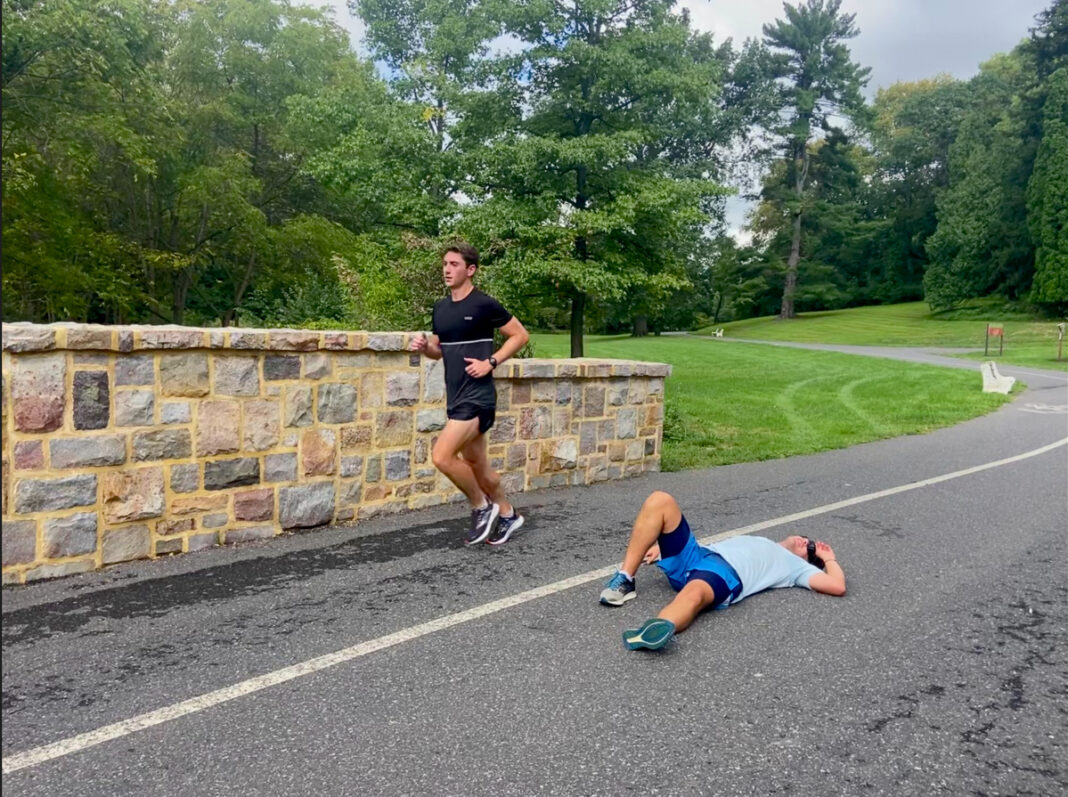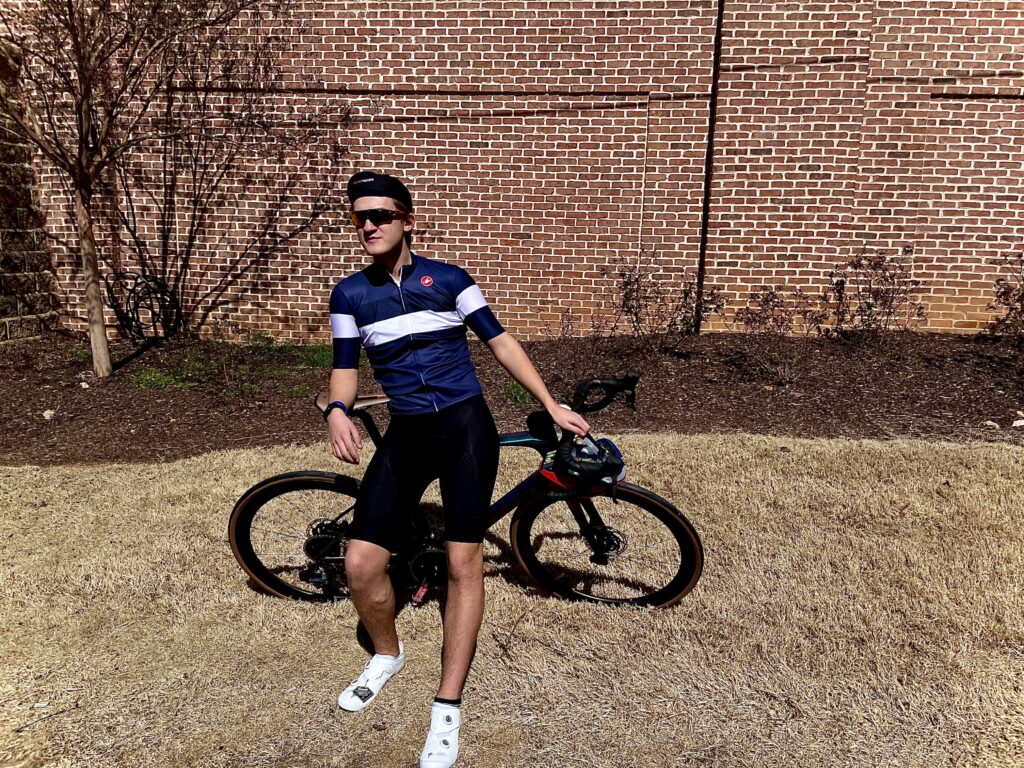“Make sure to control your breath and try to detach from the pain… you can survive it.” – Jason Ivey ‘23
One day Olivia Oberman ‘24 asked, “What if we did a sports article about whether someone can survive a cross-country workout?” Nonchalantly some guy with a death wish said, “I’ll write that.” That guy was me.
Two years ago I ran my best 5k time of 19:12 at 6:11 min/mi pace. This came after nine months of grueling cross-training. I would ride nearly 140 miles on the bike each week and run 25 too. My average of 17 miles on the bike and four miles running is a heavy taper that could generously be called a taper. Not to mention the most time I spend with the track team is either at lunch in Seegers Union or attending what we’ll call “weekend activities” on 22nd Street. My senior 5k time had turned into a freshman 15 in the span of a year. So of course I said, “I’ll write that.”
Fast forward to Sept. 12, I’m asking the guy whose profile picture on Muhlenberg Athletics looks like he’s doing the “I’m chill like that” Tik Tok dance and captain of the team Jason Ivey ‘23 if I could do a workout with him for The Weekly. Ivey, being his typical social and energetic self, said, “Sure!” As Ivey began to explain the workout for the next day, I caught out of the corner of my eye a devilish grin creeping across co-captain Conner Soderstedt’s ‘23 face. Now, I can’t quote his thought process but he was probably happy to see a NARP (Non-Athletic Regular Person) ignorantly ask to be tortured by Trexler Park pavement.
Ivey explained that the workout for the team that day was going to be a Fartlek run. This workout is meant to train a runner’s endurance at a higher intensity and train their active recovery zone. Ivey and I planned to run from the LSC to Trexler Park, approximately one and a half miles; then we’d “dig in” to the workout with two minutes at six min/mi and one minute recovery at eight min/mi 12 times, finishing the workout with a mile and a half cool down back to my training grounds, the dining hall.
It was 11 o’clock, I had just finished my class with Professor of Political Science Giacomo Gambino, Ph.D., where he gave a rousing lecture about Immanuel Kant. Now, it was time to face the music… or more likely Ivey’s well-toned calves as he gracefully left me in the dust.
Some wonder why runners like running… actually, most. Is it the runner’s high? Shorts that are way too small for you? The health benefits? A slight case of masochism? For Ivey, a lifelong athlete and former Muhlenberg Varsity Soccer player before injuries sidelined him, it is the comradery, tenacity and challenge. Plus, if his plan to attend medical school through a serve-back scholarship program through the Navy is any indication–a slight case of masochism.
During our warmup, Ivey and I discussed topics ranging from his years in student government to our common passion for finding hidden gems in the Allentown area, whether it be a covered bridge or what the cross country team calls “the field of dreams.” We found a common love for doing a thorough job in whatever our current endeavor may be because we believe all arguments must have nuance. This is the human part of running. This is the human part of the sport. Those shared moments in between labored breaths with two peers, best friends, teammates or strangers. The same bated breaths captivate the hearts and minds of fans as we wait to see who crosses the finish line or makes the diving save. In sports, we all breathe as one.
Beep…beep…beep. Quickly, the pleasant conversation dropped away and our focus shifted to the task at hand. Our first two minutes went by quickly. My legs weren’t screaming, they were just happy to be running at 6:10 again. The minute of active recovery sped by. Ivey told me, “Make sure to control your breath and try to detach from the pain… you can survive it.” Survive it?!
We continued like this for the next 12 minutes, about a third of the way through the workout when I said to Ivey, “We should make sure to stay at a faster click during recovery.” Famous last words.
About a minute into the fourth interval, my body began to have a weird sensation crossing my chest and down to my legs. My legs didn’t feel tired, but I felt dizziness in my chest. I had run out of energy. My legs were ready to keep going but my endurance at a higher intensity had dropped significantly.
I finished my workout with one more interval at a seven-minute pace (probably where I should have run the whole time). Ivey continued his workout posting negative splits on the last few. Something I certainly couldn’t have survived.
As we jogged back to campus the conversation continued as it had before, exchanging training tips, such as Ivey’s new love of aqua jogging. A workout that allows runners to develop their form and endurance, without the hazards of weight-bearing workouts.
Once we reached Scotty Wood stadium, we both looked down at our watches and realized we had to run another tenth of a mile. There was some instinct in both of us to end with round numbers. Together, we had totaled 14.5 miles with high-intensity work all before noon. A great start to the day for both of us. Even better preparation for Ivey’s upcoming race.
On Sept. 16, the cross country teams went against some heavy-hitting schools such as Villanova and Penn in the main line invitational. Both the men’s and women’s teams put on admirable performances with only a fourteen-minute gap in total time compared to the DI Villanova Wildcats. Ivey hit his personal goal of sub-24 for the four-mile course with a time of 23:46 (5:57 min/mi). The Fartlek training had paid off, he ran a great race and I was still in recovery.
If you enjoyed getting to know more about Ivey and cross country, get ready for Oct. 20 when The Weekly sports section will be releasing an article on how the Mules use their three-week training block to prepare for the Centennial Conference Championships.
Matthew joined the Weekly Sports Section in his freshman year to tell the inspiring and compelling stories that transpire over points, games, and seasons.























